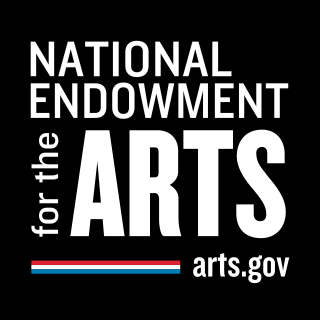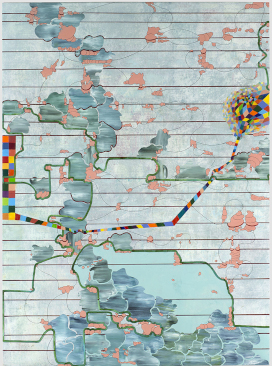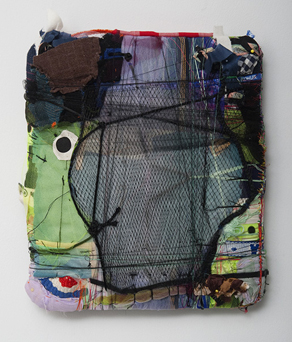Related Research Articles

The National Endowment for the Arts (NEA) is an independent agency of the United States federal government that offers support and funding for projects exhibiting artistic excellence. It was created in 1965 as an independent agency of the federal government by an act of the U.S. Congress, signed by President Lyndon B. Johnson on September 29, 1965. It is a sub-agency of the National Foundation on the Arts and the Humanities, along with the National Endowment for the Humanities, the Federal Council on the Arts and the Humanities, and the Institute of Museum and Library Services.

A visual language is a system of communication using visual elements. Speech as a means of communication cannot strictly be separated from the whole of human communicative activity which includes the visual and the term 'language' in relation to vision is an extension of its use to describe the perception, comprehension and production of visible signs.

Donald Kuspit is an American art critic and poet, known for his practice of psychoanalytic art criticism. He has published on the subjects of avant-garde aesthetics, postmodernism, modern art, and conceptual art.

Raymond Saunders is an American artist known for his multimedia paintings which often have sociopolitical undertones, and which incorporate assemblage, drawing, collage and found text. Saunders is also recognized for his installation, sculpture, and curatorial work.

William C. Harper is an NYC based American jewelry artist known for studio craft jewelry. Harper, an expert in the cloisonné technique working in enamelled glass, creates intricate pieces that combine enamel designs with gold, wood, and a variety of other materials, both valuable and ordinary. Instead of using cloisonné in the traditional way to separate areas of color, Harper utilizes silver and gold wires as a form of drawing, creating abstract linear patterns within the enamel. His work often explores the contrast between different elements, such as the beautiful and the everyday, the luxurious and the simple, and the public and the personal.
Williams is the first African American artist to be featured in The Janson History Of Art.
Judy Pfaff is an American artist known mainly for installation art and sculptures, though she also produces paintings and prints. Pfaff has received numerous awards for her work, including a John D. and Catherine T. MacArthur Foundation Fellowship in 2004 and grants from the John Simon Guggenheim Memorial Foundation (1983) and the National Endowment for the Arts. Major exhibitions of her work have been held at the University of Wisconsin–Madison, the Denver Art Museum and Saint Louis Art Museum. In 2013 she was elected to the American Academy of Arts and Sciences. Video interviews can be found on Art 21, Miles McEnery Gallery, MoMa, Mount Holyoke College Art Museum and other sources.
Squeak Carnwath is an American contemporary painter and arts educator. She is a professor emerita of art at the University of California, Berkeley. She has a studio in Oakland, California, where she has lived and worked since 1970.
Michael Loew was an American Abstract Expressionist artist who was born in New York City.

The arts or creative arts are a vast range of human practices of creative expression, storytelling, and cultural participation. The arts encompass diverse and plural modes of thinking, doing, and being in an extensive range of media. Both dynamic and a characteristically constant feature of human life have developed into stylized and intricate forms. This is achieved through sustained and deliberate study, training, or theorizing within a particular tradition, generations, and even between civilizations. The arts are a vehicle through which human beings cultivate distinct social, cultural, and individual identities while transmitting values, impressions, judgements, ideas, visions, spiritual meanings, patterns of life, and experiences across time and space.
Nancy Grossman is an American artist. Grossman is best known for her wood and leather sculptures of heads.

Ted Stamm (1944–1984) was an American minimalist and conceptualist artist.
Cynthia Carlson is an American visual artist, living and working in New York.
Kay Rosen is an American painter. Rosen's paintings are included in the collections of the Art Institute of Chicago, the Museum of Contemporary Art, Los Angeles, and the Museum of Modern Art, Whitney Museum of American Art in New York City, and The Blanton Museum of Art in Austin, Texas. Rosen lives in Gary, Indiana, and New York City.

Lisa Corinne Davis is an American visual artist known for abstract paintings and works on paper that suggest maps and other encoded forms of knowledge. She employs abstraction as a means of rendering the complexities of contemporary experience—including her own as an African-American woman—often questioning preconceived notions about identity, classification, and rationality versus subjectivity. Her densely layered, colorful work merges contrasting schemas, visual elements and formal languages, blurring distinctions between figuration and abstraction, real and fictive spaces and concepts, and microcosmic or macrocosmic reference. Brooklyn Rail critic Joan Waltemath wrote, "The urban experiences of space and time that Davis presents are subtle distillations of moment and coincidence ... Her attempt to map the shattered terrain of contemporary life points both to an awareness of other times and a belief in navigating the present one."

Judith Poxson Fawkes was an American tapestry weaver based in Portland, Oregon, who exhibited her works nationally beginning in the 1960s.

Lia Cook is an American fiber artist noted for her work combining weaving with photography, painting, and digital technology. She lives and works in Berkeley, California, and is known for her weavings which expanded the traditional boundaries of textile arts. She has been a professor at California College of the Arts since 1976.

Julia Couzens is a California-based, American artist known for a diverse body of work that embraces unconventional materials and methods and includes drawing, sculpture, installation art, and writing. Critic David Roth identifies as a connecting thread in her evolving work, her "decidedly surrealist-symbolist sensibility, in which eroticism, the grotesque and the gothic mix in equal parts." Her work has been shown internationally and throughout the United States, including solo exhibitions at the Christopher Grimes Gallery and California State University, Stanislaus (2009), in surveys at the University of California, Davis and Sonoma Museum of Visual Art (1999), and group shows at the Crocker Art Museum, P•P•O•W, Orange County Museum of Art, Hammer Museum, and BAMPFA, among others. Her art has been reviewed in the Los Angeles Times, San Francisco Chronicle, Flash Art, New Art Examiner, and Art Practical, among other publications, and collected by institutions including the Crocker Art Museum, Fine Arts Museums of San Francisco, Oakland Museum of California and Butler Institute of American Art, among many. In addition to working as an artist, Couzens has taught at several Southern California universities and writes about contemporary art for The Sacramento Bee and Squarecylinder. She lives and works on Merritt Island in the Sacramento River delta community of Clarksburg and maintains a studio in downtown Los Angeles.

Andrew Spence is an American artist known for abstract paintings that combine a minimalist vocabulary with playful references to the observed world. In the 1970s and 1980s, he gained recognition as one of a number of younger artists who were re-examining geometric modernism through a contemporary lens that invited humor and reference to everyday objects and life experience into the tradition. Spence's method of distilling visual phenomena into simple, emblematic images has been compared to Ellsworth Kelly, but his work has differed in its more even balance between abstraction and recognition, intuitive approach, and varied, expressive paint surfaces. Art in America critic Ken Johnson wrote that his work maintains "an ironic tension between lofty purism of modernist geometry and earth-bound ordinariness of the vernacular sources." In later paintings, Spence has increasingly obscured the original inspirations of his abstractions, in both form and titling. His work belongs to the permanent collections of the Metropolitan Museum of Art, Museum of Modern Art, and Whitney Museum of American Art, among others. He has received a Guggenheim Fellowship and awards from the American Academy of Arts and Letters and National Endowment for the Arts.
Caroline Kent is an American visual artist based in Chicago, best known for her large scale abstract painting works that explore the interplay between language and translation. Inspired by her own personal experiences and her cultural heritage, Kent creates paintings that explore the power and limitations of communication. Her work, influenced by her Mexican heritage, delves into the potentials and confines of language and reconsiders the modernist canon of abstraction. She likens her composition process to choreography, revealing an interconnectedness between language, abstraction, and painting. Kent's artwork showcases an evolving dialogue of space, matter, and time, resulting in a confluence of drawings, paintings, sculpture, and performance, blurring the lines between these mediums.
References
- ↑ Rasula, Jed; McCaffery, Steve (2001). Imagining Language: An Anthology. MIT Press. ISBN 978-0-262-68131-5.
- ↑ Winkler, Michael (2021-08-17). The Image of Language: An Artist's Memoir. Artists Books Editions. ISBN 978-1-7363881-0-5.
- ↑ Winkler, Michael Joseph (2015). "New Discoveries Should Reopen the Discussion of Signs". Alternative Theoretics. 2015: 12.
- ↑ Winkler, Michael. "" POETRY OF ZEBRAS " adapted from Likeness & Language".
{{cite journal}}: Cite journal requires|journal=(help) - ↑ Winkler, Michael (May–June 2010). "Ancient Art & Modern Language" (PDF). Pleistocene Coalition News: 1–3.
- 1 2 3 "Winkler, Michael, 1952- (American visual artist) | ArchivesSpace at the University of Iowa". aspace.lib.uiowa.edu. Retrieved 2022-04-08.
- ↑ "About – Michael Winkler Art" . Retrieved 2022-04-08.
- 1 2 Winkler, Michael Joseph (2021), "A Major Challenge", The Image of Language, retrieved 2022-04-08
- ↑ "Michael Winkler". www.library.upenn.edu. Retrieved 2022-04-08.
- ↑ Daniels, Clare (April 8, 2022). "Winkler, Michael Joseph". NYARC: Museum of Modern Art & Brooklyn Museum Libraries. Retrieved April 8, 2022.
- ↑ "Results for 'au:Winkler, Michael Joseph.' [WorldCat.org]". www.worldcat.org. Retrieved 2022-04-08.
- ↑ "Michael Winkler, New York/USA".
- ↑ Princenthal, Nancy; Ivey, Bill; Dowley, Jennifer (2001). A creative legacy : A history of the National Endowment for the Arts Visual Artists' Fellowship Program, 1966-1995. ISBN 9780810941700.